Page 519 of 616
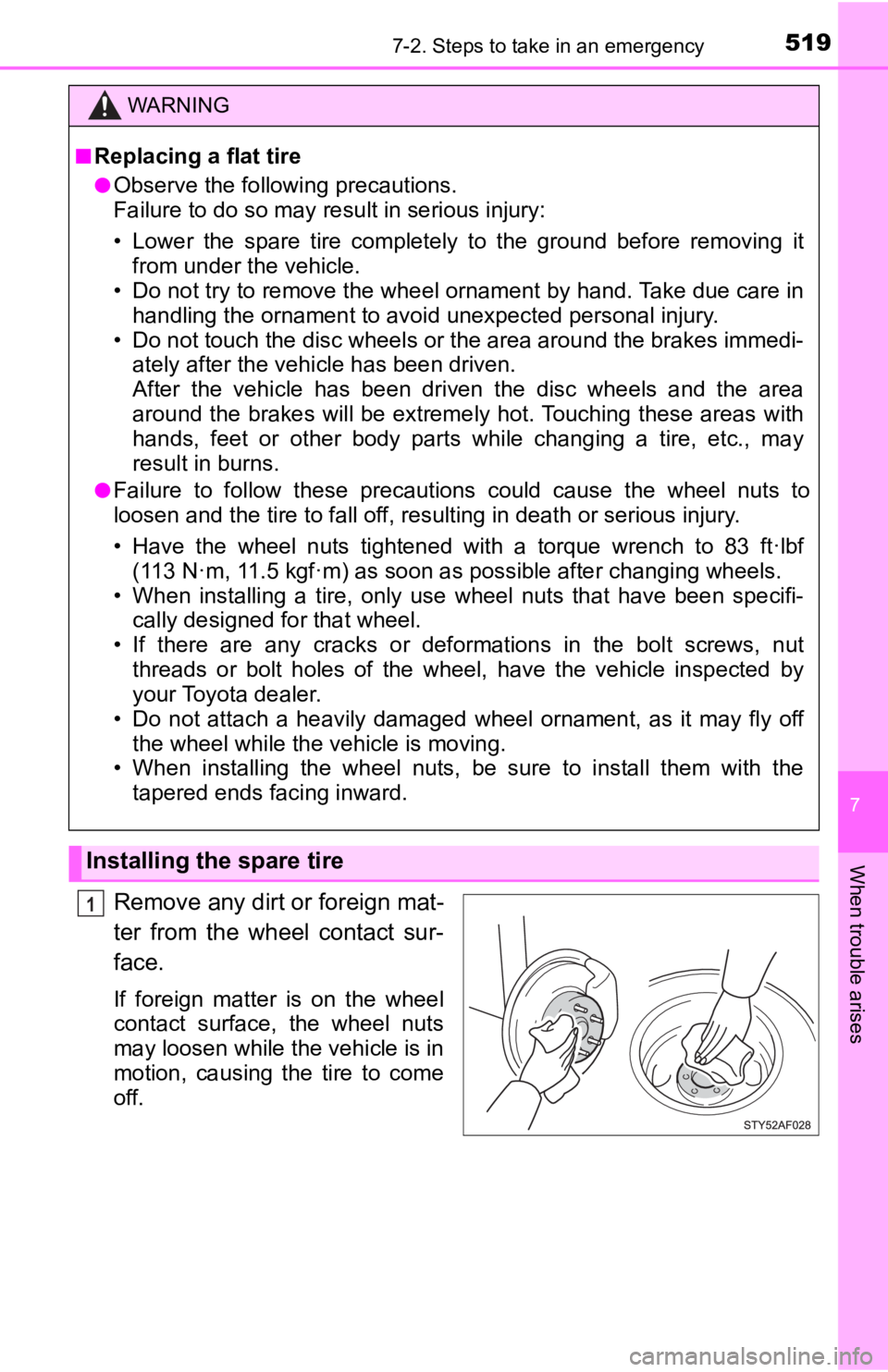
5197-2. Steps to take in an emergency
7
When trouble arises
Remove any dirt or foreign mat-
ter from the wheel contact sur-
face.
If foreign matter is on the wheel
contact surface, the wheel nuts
may loosen while the vehicle is in
motion, causing the tire to come
off.
WARNING
■Replacing a flat tire
●Observe the following precautions.
Failure to do so may result in serious injury:
• Lower the spare tire completely to the ground before removing it
from under the vehicle.
• Do not try to remove the wheel ornament by hand. Take due care in
handling the ornament to avoi d unexpected personal injury.
• Do not touch the disc wheels or the area around the brakes imm edi-
ately after the vehicle has been driven.
After the vehicle has been driven the disc wheels and the area
around the brakes will be extremely hot. Touching these areas w ith
hands, feet or other body parts while changing a tire, etc., ma y
result in burns.
●Failure to follow these precautions could cause the wheel nuts to
loosen and the t ire to fall off, resulting in death or serious injury.
• Have the wheel nuts tightened with a torque wrench to 83 ft·lb f
(113 N·m, 11.5 kgf·m) as soon as possible after changing wheels.
• When installing a tire, only use wheel nuts that have been spe cifi-
cally designed for that wheel.
• If there are any cracks or defo rmations in the bolt screws, nut
threads or bolt holes of the wheel, have the vehicle inspected by
your Toyota dealer.
• Do not attach a heavily damaged wheel ornament, as it may fly off
the wheel while the vehicle is moving.
• When installing the wheel nuts, be sure to install them with t he
tapered ends facing inward.
Installing the spare tire
1
Page 521 of 616
5217-2. Steps to take in an emergency
7
When trouble arises
Lower the vehicle.
Firmly tighten each nut two or
three times in the order shown
in the illustration.
Tightening torque:
83 ft·lbf (113 N·m, 11.5 kgf·m)
3
4
WARNING
■Stowing the flat tire
Failure to follow steps listed under stowing the tire may result in damage
to the spare tire carrier and loss of the tire, which could res ult in death or
serious injury.
Page 522 of 616
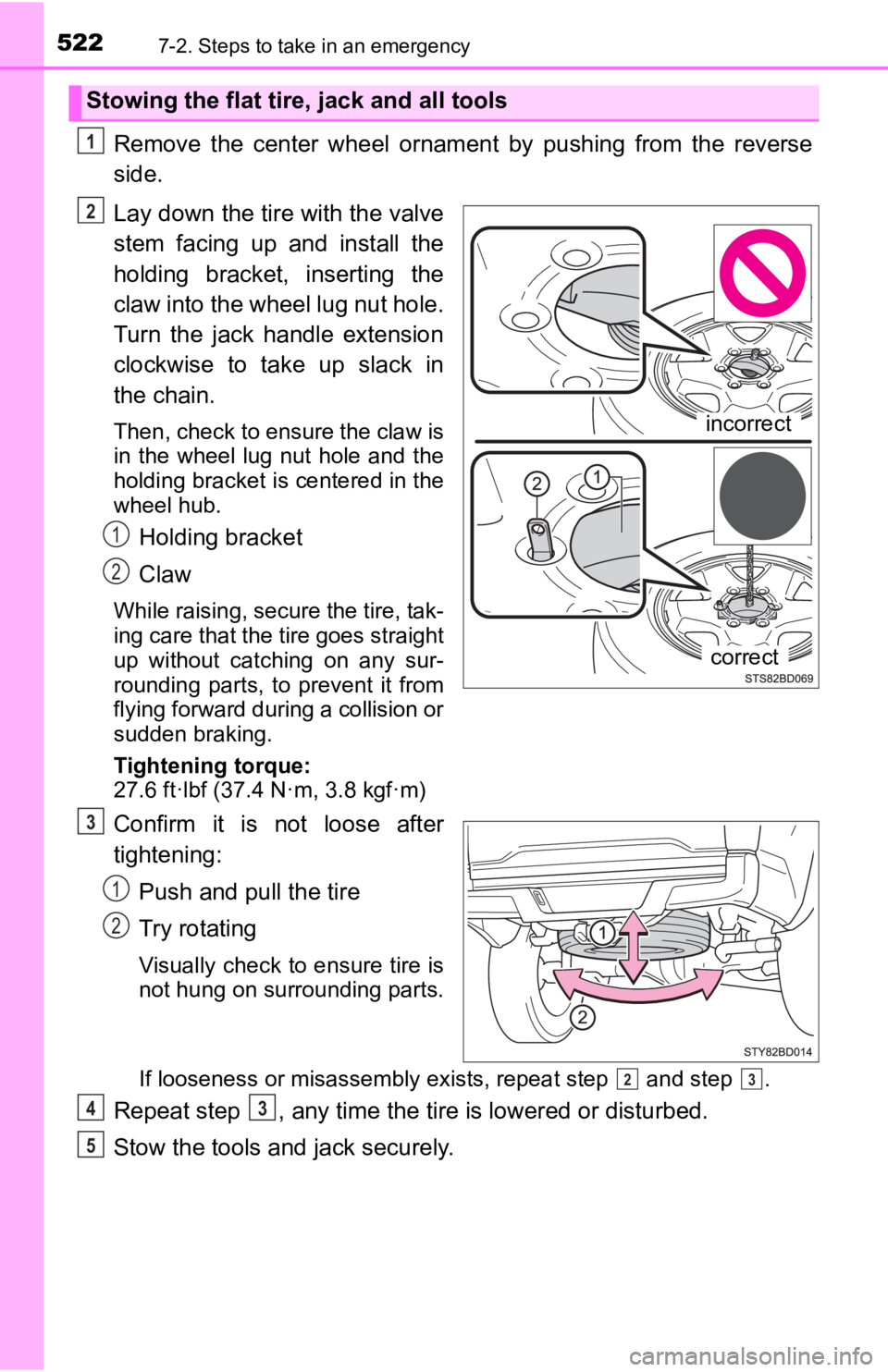
5227-2. Steps to take in an emergency
Remove the center wheel ornament by pushing from the reverse
side.
Lay down the tire with the valve
stem facing up and install the
holding bracket, inserting the
claw into the wheel lug nut hole.
Turn the jack handle extension
clockwise to take up slack in
the chain.
Then, check to ensure the claw is
in the wheel lug nut hole and the
holding bracket is centered in the
wheel hub.
Holding bracket
Claw
While raising, secure the tire, tak-
ing care that the tire goes straight
up without catching on any sur-
rounding parts, to prevent it from
flying forward during a collision or
sudden braking.
Tightening torque:
27.6 ft·lbf (37.4 N·m, 3.8 kgf·m)
Confirm it is not loose after
tightening:
Push and pull the tire
Try rotating
Visually check to ensure tire is
not hung on surrounding parts.
If looseness or misassembly ex ists, repeat step and step .
Repeat step , any time the tire is lowered or disturbed.
Stow the tools and jack securely.
Stowing the flat tire, jack and all tools
1
incorrect
correct
2
1
2
3
1
2
23
43
5
Page 523 of 616
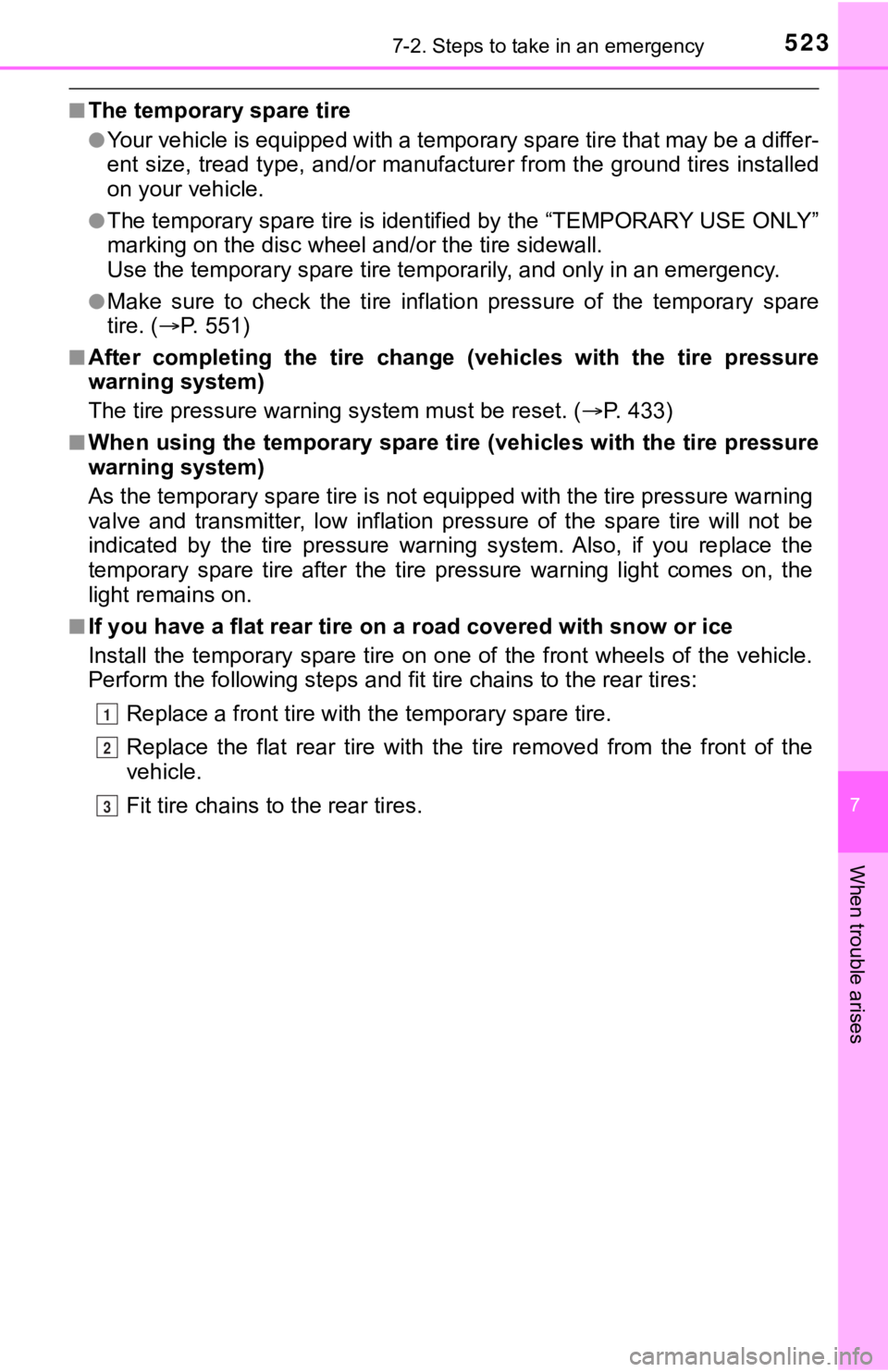
5237-2. Steps to take in an emergency
7
When trouble arises
■The temporary spare tire
●Your vehicle is equipped with a temporary spare tire that may be a differ-
ent size, tread type, and/or manufacturer from the ground tires installed
on your vehicle.
●The temporary spare tire is iden tified by the “TEMPORARY USE ON LY ”
marking on the disc wheel and/or the tire sidewall.
Use the temporary spare tire temp orarily, and only in an emergency.
●Make sure to check the tire inflation pressure of the temporary spare
tire. ( P. 5 5 1 )
■After completing the tire change (vehicles with the tire pressu re
warning system)
The tire pressure warni ng system must be reset. ( P. 433)
■When using the temporary spare tire (vehicles with the tire pre ssure
warning system)
As the temporary spare tire is no t equipped with the tire pressure warning
valve and transmitter, low inflation pressure of the spare tire will not be
indicated by the tire pressure warning system. Also, if you rep lace the
temporary spare tire after the tire pressure warning light come s on, the
light remains on.
■If you have a flat rear tire on a road covered with snow or ice
Install the temporary spare tire on one of the front wheels of the vehicle.
Perform the following steps and f it tire chains to the rear tires:
Replace a front tire with the temporary spare tire.
Replace the flat rear tire with the tire removed from the front of the
vehicle.
Fit tire chains to the rear tires.
1
2
3
Page 525 of 616
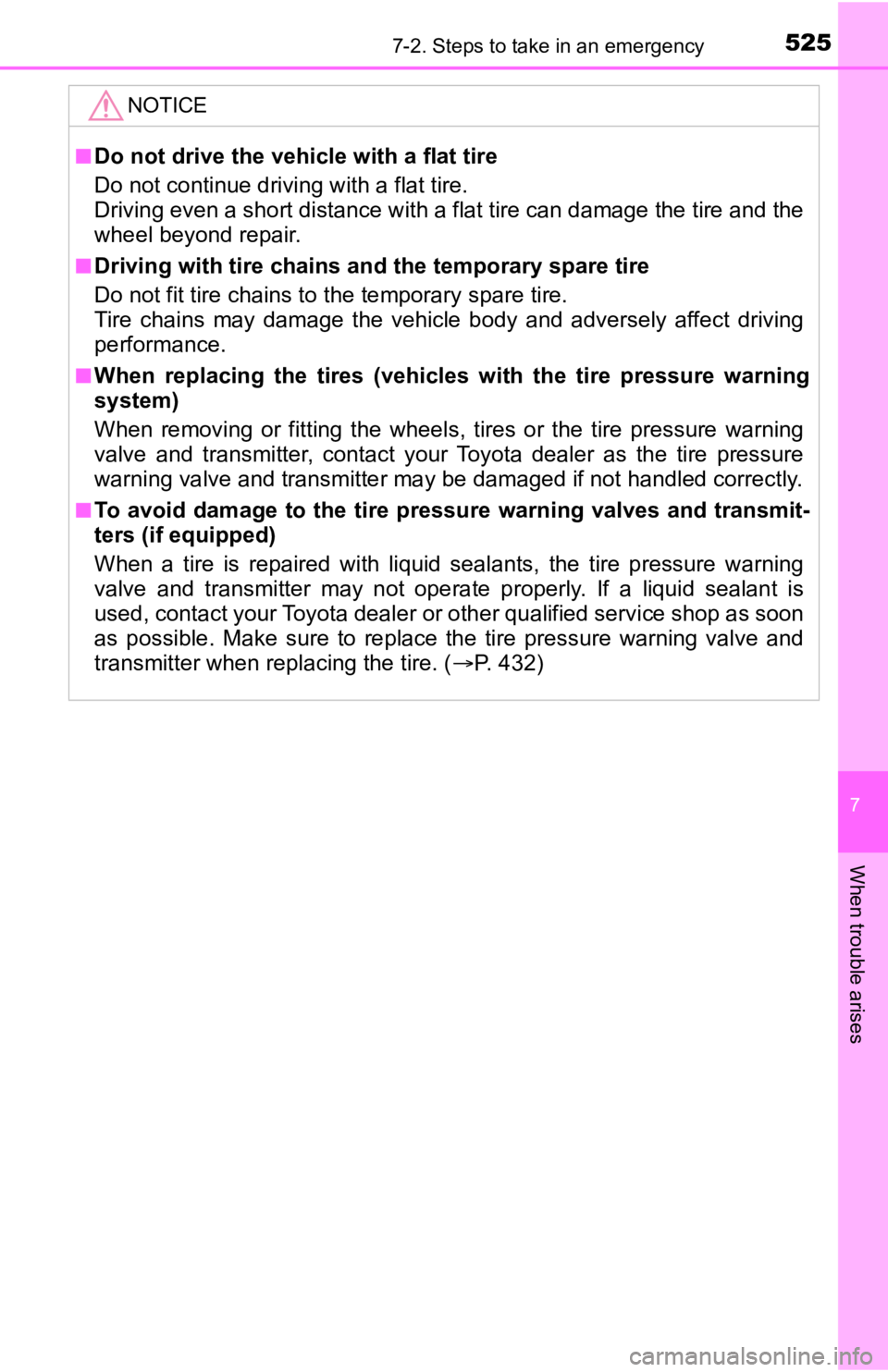
5257-2. Steps to take in an emergency
7
When trouble arises
NOTICE
■Do not drive the vehicle with a flat tire
Do not continue driving with a flat tire.
Driving even a short distance with a flat tire can damage the tire and the
wheel beyond repair.
■Driving with tire chains a nd the temporary spare tire
Do not fit tire chains to t he temporary spare tire.
Tire chains may damage the vehicle body and adversely affect dr iving
performance.
■When replacing the tires (vehicles with the tire pressure warning
system)
When removing or fitting the wheels, tires or the tire pressure warning
valve and transmitter, contact your Toyota dealer as the tire p ressure
warning valve and transmitter may be damaged if not handled correctly.
■To avoid damage to the tire pressure warning valves and transmi t-
ters (if equipped)
When a tire is repaired with liquid sealants, the tire pressure warning valve and transmitter may not operate properly. If a liquid sea lant is
used, contact your Toyota dealer or other qualified service shop as soon
as possible. Make sure to replace the tire pressure warning valve and
transmitter when replacing the tire. ( P. 432)
Page 551 of 616
5518-1. Specifications
8
Vehicle specifications
Ty p e A
Ty p e B
Tires and wheels
Tire sizeP245/75R16 109S
Tire inflation pressure
(Recommended cold
tire inflation pressure)
Front tires:
32 psi (220 kPa, 2.2 kgf/cm2 or bar)
Rear tires:
32 psi (220 kPa, 2.2 kgf/cm
2 or bar)
Spare tire:
32 psi (220 kPa, 2.2 kgf/cm
2 or bar)
Wheel size16 × 7 J, 16 × 7 JJ (spare wheel)
Wheel nut torque83 ft·lbf (113 N·m, 11.5 kgf·m)
Tire size265/70R16 112T
Tire inflation pressure
(Recommended cold
tire inflation pressure)
Front tires:
30 psi (210 kPa, 2.1 kgf/cm2 or bar)
Rear tires:
30 psi (210 kPa, 2.1 kgf/cm
2 or bar)
Spare tire:
30 psi (210 kPa, 2.1 kgf/cm
2 or bar)
Wheel size16 × 7 J, 16 × 7 JJ (spare wheel)
Wheel nut torque83 ft·lbf (113 N·m, 11.5 kgf·m)
Page 552 of 616
5528-1. Specifications
Ty p e C
Tire sizeP265/65R17 110S, P265/60R18 109H,
P245/75R16 109S (spare tire)
Tire inflation pressure
(Recommended cold
tire inflation pressure)
Front tires:
29 psi (200 kPa, 2.0 kgf/cm2 or bar)
Rear tires:
29 psi (200 kPa, 2.0 kgf/cm
2 or bar)
Spare tire:
32 psi (220 kPa, 2.2 kgf/cm
2 or bar)
Wheel size17 7 1/2 J, 18 7 1/2 J,
16 7 JJ (spare wheel)
Wheel nut torque83 ft·lbf (113 N·m, 11.5 kgf·m)
Page 557 of 616
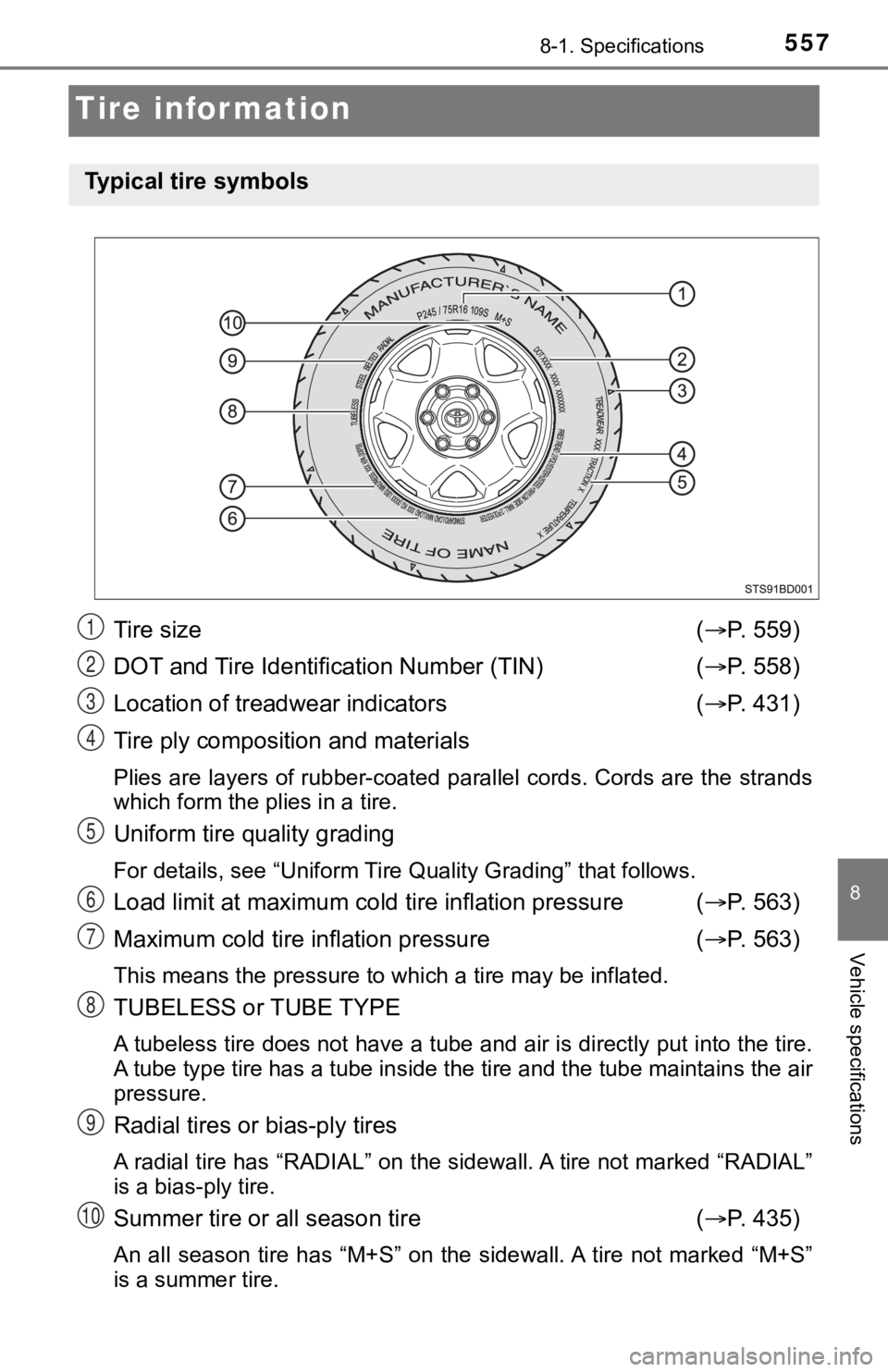
5578-1. Specifications
8
Vehicle specifications
Tire information
Tire size ( P. 559)
DOT and Tire Identification Number (TIN) ( P. 558)
Location of treadwear indicators ( P. 431)
Tire ply composition and materials
Plies are layers of rubber-coated parallel cords. Cords are the strands
which form the p lies in a tire.
Uniform tire quality grading
For details, see “Uniform Tire Q uality Grading” that follows.
Load limit at maximum cold tire inflation pressure ( P. 563)
Maximum cold tire inflation pressure ( P. 563)
This means the press ure to which a tire may be inflated.
TUBELESS or TUBE TYPE
A tubeless tire does not have a tube and air is directly put into the tire.
A tube type tire has a tube insi de the tire and the tube mainta ins the air
pressure.
Radial tires or bias-ply tires
A radial tire has “RADIAL” on the sidewall. A tire not marked “ RADIAL”
is a bias-ply tire.
Summer tire or all season tire ( P. 435)
An all season tire has “M+S” on the sidewall. A tire not marked “M+S”
is a summer tire.
Typical tire symbols
1
2
3
4
5
6
7
8
9
10